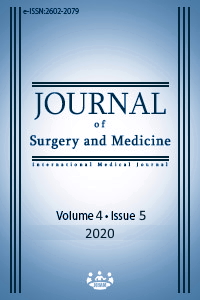Anesthesia in Morgagni hernia with high PIP: A case report
Keywords:
congenital diaphragmatic hernia, Morgagni hernia, AnesthesiaAbstract
Morgagni hernia, a congenital diaphragmatic hernia, is usually asymptomatic. Surgery should be planned as soon as possible after diagnosis. The observation of variable degrees of pulmonary dysplasia and increased vascular resistance, and the presence of heart or other organ disorders make anesthesia management important. We describe the anesthetic management of a 2.5-month-old patient operated due to Morgagni hernia. Following intubation, peak inspiratory pressure was high, but rapidly returned to normal levels after the abdomen was opened. No complications were observed during this process in terms of anesthesia management.
Downloads
References
McHoney M. Congenital diaphragmatic hernia, management in the newborn. Pediatr Surg Int. 2015;31:1-9.
Rau HG, Schardey HM, Lange V. Laparoscopic repair of a Morgagni hernia. Surg Endosc. 1994;8:1439-42.
Nawaz A, Matta H, Jacobsz A, Al-Khouder G, Al-Salem. Congenital Morgagni’s hernia in infants and children. Int Surg. 2000;85:158-62.
Al-Salem AH, Nawaz A, Matta H, Jacobsz A. Herniation through the foramen of Morgagni: Early diagnosis and treatment. Pediatr Surg Int 2002;18:93-7.
Çiğdem MK, Önen A, Okur H, Otçu S. Associated malformations in Morgagni hernia. Pediatr Surg Int. 2007;23:1101-3.
Snoek KG, Reiss IK, Greenough A, Capolupo I, Urlesberger B, Wessel L, et al. Standardized postnatal management of infants with congenital diaphragmatic hernia in Europe: the CDH EURO consortium consensus - 2015 update. Neonatology. 2016;110:66-74.
LaRosa DV Jr, Esham RH, Morgan SL, Wing SW. Diaphragmatic hernia of Morgagni. South Med J. 1999;92:409-11.
Zani A, Lamas-Pinheiro R, ParaboschiI, King SK, Wolinska J, Zani-Ruttenstock E, et al. Intraoperative acidosis and hypercapnia during thoracoscopic repair of congenital diaphragmatic hernia and esophageal atresia/ tracheoesophageal fistula. Paediatr Anaesth. 2017;27:841-8.
Herati AS, Andonian S, Rais-Bahrami S, Attala MA, Srinivasan AK, Richstone I, et al. Use of the valvless trocar system reduces carbon dioxide absorption during laparoscopy when compared with standard trocars. Urology. 2011;77:1126-32.
Katz RI, Belenker SL, Poppers PJ. Intraoperative management of a patient with a chronic, previously undiagnosed traumatic diaphragmatic hernia. J Clin Anesth. 1998;10:506-9.
Esener ZK. Torasik girişimlerde anestezi. In Esener ZK, ed. Pediatrik Anestezi. Feryal Matbaacılık Ltd. Şti. p. 229-240.
Williams DJ, Sandby-Thomas MG. Anaesthetic management of acute gastric volvulus in an adult. Br J Anaesth. 2003;90:96-8.
Salas AA, Bhat R, Dabrowska K, Leadford A, Anderson S, Harmon CM, et al. The value of pa(CO2) in relation to outcome in congenital diaphragmatic hernia. Am J Perinatol. 201;7:433-9.
Stewart TE, Meade MO, Cook DJ, Granton JT, Hodder RV, Lapinsky SE, et al. Evaluation of a ventilation strategy to prevent barotrauma in patients at high risk for acute respiratory distress syndrome. Pressure- and Volume-Limited Ventilation Strategy Group. N Engl J Med. 1998;338:355-61.
Rocha G, Baptista MJ, Correia- Pinto J, Guimaraes H. Congenital diaphragmatic hernia: experience of 14 years. Minerva Pediatr. 2013;65:271-8.
Downloads
- 424 911
Published
Issue
Section
How to Cite
License
Copyright (c) 2020 Duygu Demiriz Gulmez, Hilal Kırcı, Koray Kürekçi, Gül Şalcı
This work is licensed under a Creative Commons Attribution-NonCommercial-NoDerivatives 4.0 International License.
















